Historic Zia Pueblo Polychrome Scallop Rim Jar - 24707
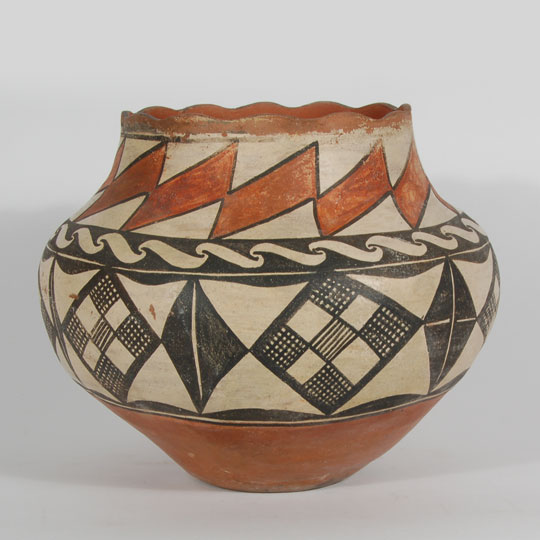 This is an exceptional small Zia Pueblo olla that dates to the early 20th Century (1910-1920). It is coil formed from native clay with the addition of crushed basaltic lava as a tempering agent.
This is an exceptional small Zia Pueblo olla that dates to the early 20th Century (1910-1920). It is coil formed from native clay with the addition of crushed basaltic lava as a tempering agent.
The underbody is stone-polished, with the ubiquitous (until 1930) red banding at the top of the under body. The neck interior is red-slipped to the upper shoulder, just below the scalloped rim, which shows evidence of having been painted in black mineral pigments. The upper body is white-slipped and stone-polished, with black and red mineral pigment design motifs. The underbody is concave.
#adobegallery #SouthwestIndianPottery #ZiaPueblo #ZiaPottery #PuebloPottery #SouthwestIndianArt #SantaFePottery #FinePuebloPottery #HistoricPottery
Large Historic Zia Pueblo Polychrome Dough - 24706
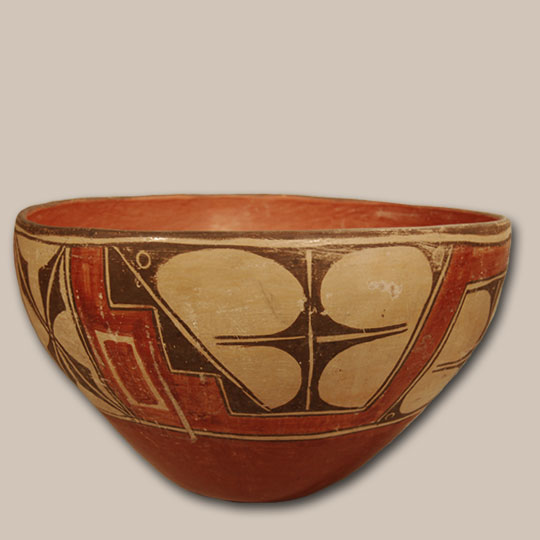 This is an exceptionally deep historic dough bowl from Zia Pueblo, created most probably in the 1920s. This fine piece was coil-formed in native clay with the addition of crushed basaltic temper. The underbody was stone-polished over the bare paste in a warm brick red color. A narrow red band was wiped on as a dividing line between the bare paste underbody and the decorated upper body. The design field was slipped in a creamy white slip on which was prominently displayed the traditional design seen on almost every Zia dough bowl.
This is an exceptionally deep historic dough bowl from Zia Pueblo, created most probably in the 1920s. This fine piece was coil-formed in native clay with the addition of crushed basaltic temper. The underbody was stone-polished over the bare paste in a warm brick red color. A narrow red band was wiped on as a dividing line between the bare paste underbody and the decorated upper body. The design field was slipped in a creamy white slip on which was prominently displayed the traditional design seen on almost every Zia dough bowl.
Historic Kewa - Santo Domingo Pueblo Water Jar - C3802
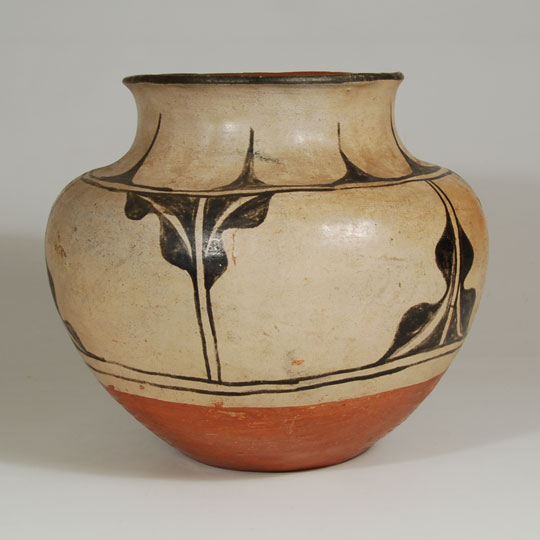 Most often the design is the determining factor of the desirability of a jar by a collector. Occasionally, however, it is the vessel shape that first captures one's eye. This is generally true when the design is not overwhelming and obliterating the vessel shape.
Most often the design is the determining factor of the desirability of a jar by a collector. Occasionally, however, it is the vessel shape that first captures one's eye. This is generally true when the design is not overwhelming and obliterating the vessel shape.
This early Santo Domingo jar has a very minimal design with the cream slip predominating. These design choices make the vessel's shape seem even more captivating. The jar rises up from the base in an outward swell to the mid-point, and then curves in to a sharp shoulder. It then reverses to a concave curve that ends with a flared rim. It is the voluminous body, high shoulder and restricted neck that combine to make this an amazingly beautiful vessel.
Zuni Pueblo Buffalo Katsina Doll - C3805G
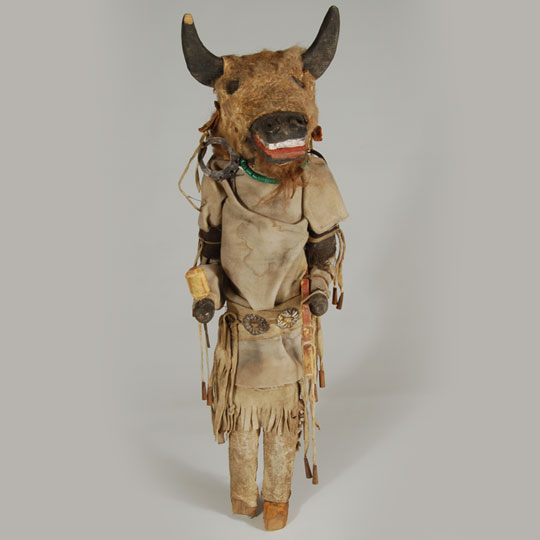 Probably the most significant Katsina doll ever made was a Buffalo Katsina doll, dating to 1885. It was stolen from Millicent Rogers Museum in Taos, New Mexico, a number of years ago. Some would agree that it is the most significant Native American object ever made. To the Zuni, Katsina dolls are not considered tourist objects and Zuni elders disapprove of them being sold. There are a number of doll carvers at Zuni today who do make them for sale, so they have not been forced to discontinue doing so.
Probably the most significant Katsina doll ever made was a Buffalo Katsina doll, dating to 1885. It was stolen from Millicent Rogers Museum in Taos, New Mexico, a number of years ago. Some would agree that it is the most significant Native American object ever made. To the Zuni, Katsina dolls are not considered tourist objects and Zuni elders disapprove of them being sold. There are a number of doll carvers at Zuni today who do make them for sale, so they have not been forced to discontinue doing so.
Black-on-black Feather Design Dish signed Maria + Santana - 25723
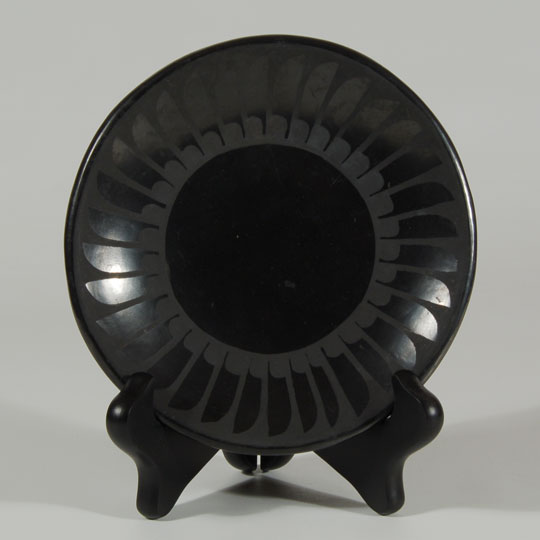 This San Ildefonso Pueblo plate is signed Maria & Santana, the later signature, indicating that it was made after 1956. Maria made the plate and Santana decorated it with eagle feathers, one of the favorite designs of Julian which was continued both by her other son, Popovi Da, and Santana.
This San Ildefonso Pueblo plate is signed Maria & Santana, the later signature, indicating that it was made after 1956. Maria made the plate and Santana decorated it with eagle feathers, one of the favorite designs of Julian which was continued both by her other son, Popovi Da, and Santana.
Black-on-black Feather Design Jar signed Marie + Santana - 25722
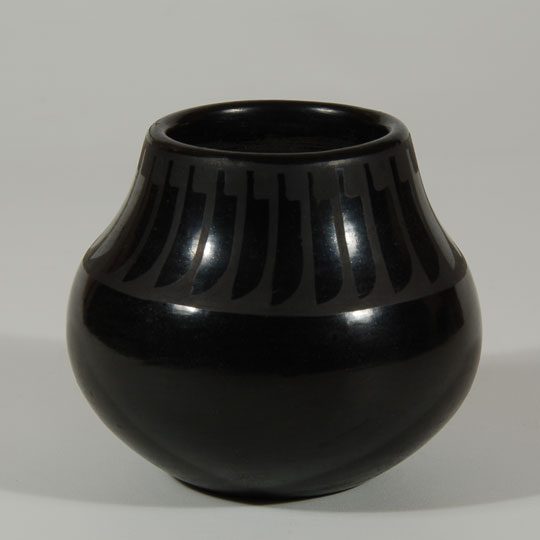 Maria and Julian had four sons: Adam, John, Popovi Da, and Philip. Adam's wife was Santana and it was she who worked with Maria following the death of Julian in 1943. There are two periods of pottery that were collaborated by Maria and Santana. The earlier ones were signed Marie + Santana and that period lasted from Julian's death in 1943 until 1956, at which time Popovi Da replaced Santana and helped his mom. Maria did not immediately stop working with Santana when she began working with Popovi but did continue on and off for a few more years. Those pieces are signed Maria + Santana.
Maria and Julian had four sons: Adam, John, Popovi Da, and Philip. Adam's wife was Santana and it was she who worked with Maria following the death of Julian in 1943. There are two periods of pottery that were collaborated by Maria and Santana. The earlier ones were signed Marie + Santana and that period lasted from Julian's death in 1943 until 1956, at which time Popovi Da replaced Santana and helped his mom. Maria did not immediately stop working with Santana when she began working with Popovi but did continue on and off for a few more years. Those pieces are signed Maria + Santana.
Four Color Polychrome Seed Jar by Chakoptewa (Michael Hawley) - C3644A
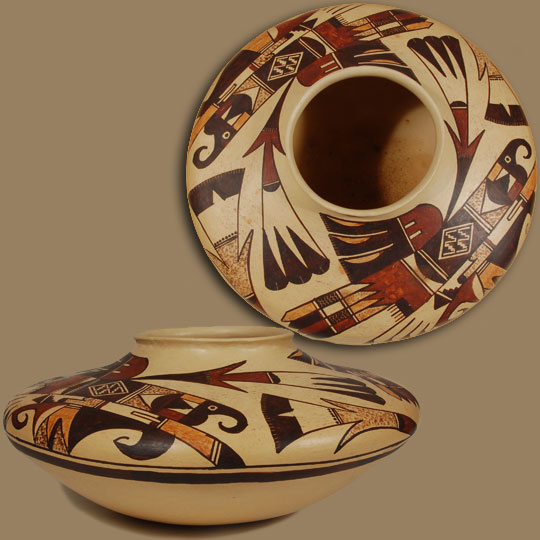 Michael Hawley, formerly of Scottsdale, Arizona, who passed away in 2012, was the only living potter creating true Sikyatki Polychrome pottery vessels in the same manner as they were originally made from the 14th through the 17th centuries. Hawley called this pottery Chakoptewa Polychrome-Chakoptewa being his adopted Hopi name.
Michael Hawley, formerly of Scottsdale, Arizona, who passed away in 2012, was the only living potter creating true Sikyatki Polychrome pottery vessels in the same manner as they were originally made from the 14th through the 17th centuries. Hawley called this pottery Chakoptewa Polychrome-Chakoptewa being his adopted Hopi name.
Hawley used only hand-ground clay dug on Antelope Mesa on the Hopi Reservation and he hand coiled, shaped, polished, painted and coal fired each of these pots in a firing pit he constructed himself. All of his pigments were made by hand from minerals and plants indigenous to the Hopi Mesas and each of his painted designs was original and within the Sikyatki design tradition.
New Mexico Handmade Tin Box with Miniature Harrison Begay Watercolor - C3643
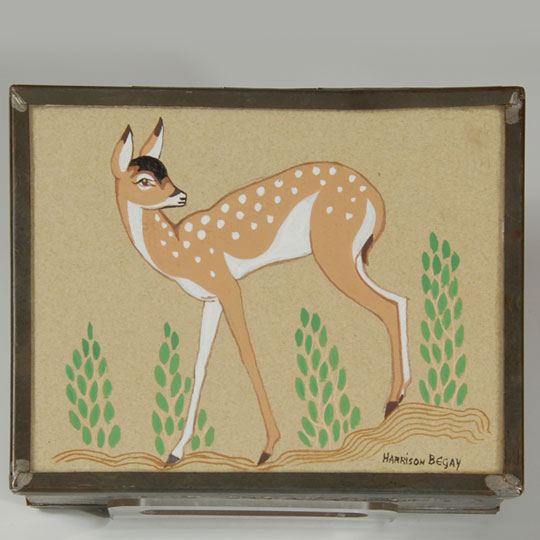 This tin box bears all the hallmarks of a New Mexican tinsmith. It was made from sheet tin and soldered in the traditional manner. Semicircle punched designs are on all four sides of the top edge of the box. An original painting of a fawn by Navajo artist Harrison Begay was inserted under glass on the box lid.
This tin box bears all the hallmarks of a New Mexican tinsmith. It was made from sheet tin and soldered in the traditional manner. Semicircle punched designs are on all four sides of the top edge of the box. An original painting of a fawn by Navajo artist Harrison Begay was inserted under glass on the box lid.
Hopi Pueblo Small Seed Jar with Monochromatic Design - C3672D
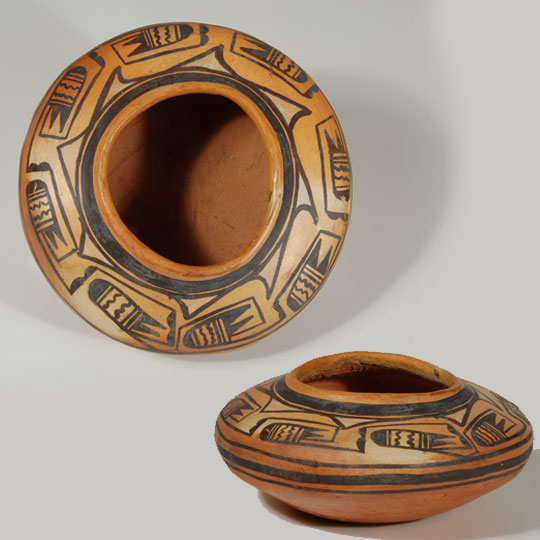 This is truly a wonderful small jar that is, without doubt, from the hands of an experienced potter. The vessel shape is reminiscent of Sikyatki seed jars that were the precedent for many of the 19th century Hopi wares. The thin vessel wall, the slightly raised and defined lip and execution of the design all are indicators of superior workmanship.
This is truly a wonderful small jar that is, without doubt, from the hands of an experienced potter. The vessel shape is reminiscent of Sikyatki seed jars that were the precedent for many of the 19th century Hopi wares. The thin vessel wall, the slightly raised and defined lip and execution of the design all are indicators of superior workmanship.
Early Hopi Pueblo Small Seed Jar with Black and White Design - C3642C
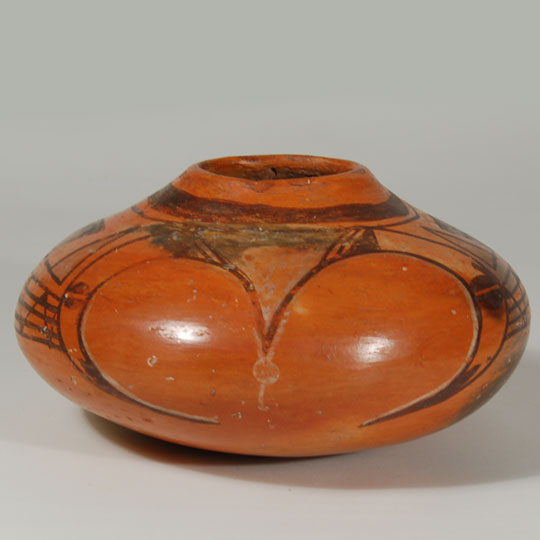 This small Hopi Pueblo seed jar is rather primitive in construction and paint application, traits that add greatly to its charm. The first impression, on seeing the white painted design, was to suggest that it was made by Annie Healing, but Annie was too sophisticated in pottery production to make an item with the looseness of design of this one.
This small Hopi Pueblo seed jar is rather primitive in construction and paint application, traits that add greatly to its charm. The first impression, on seeing the white painted design, was to suggest that it was made by Annie Healing, but Annie was too sophisticated in pottery production to make an item with the looseness of design of this one.
The design that appears as two outstretched arms with a white-painted triangle in their center, is certainly a Sikyatki-derived design, one reintroduced by Nampeyo during her career. Also, the small white-outlined circle with a tail dangling down that is appended to the white triangle, is a Sikyatki design. Nampeyo and Annie both used these designs in their pottery but it would be difficult to say with assurance that one of them made this jar.
San Ildefonso Pueblo Black-on-black Low Jar signed Maria/Popovi - 25720
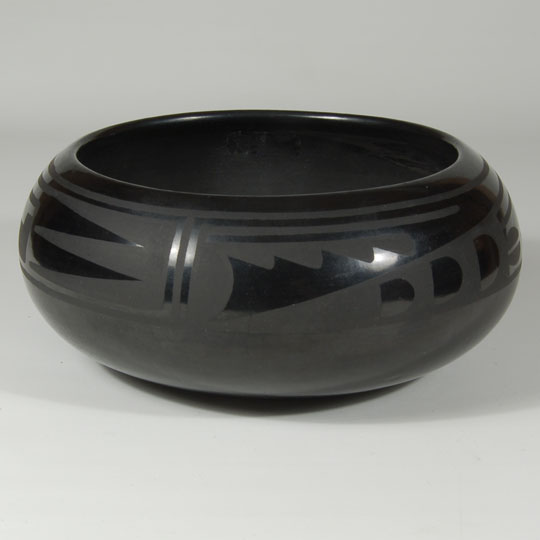 Richard Spivey, in his book The Legacy of Maria Poveka Martinez, states that Popovi Da collaborated with Maria Martinez from 1956 to 1970. Popovi initiated the process of adding the date to pottery in 1959. This jar is signed simply Maria/Popovi, without a date, so it was made between 1956 and 1959. In these earlier collaborative pieces, Popovi used traditional designs that had been used by his dad. In this example he used precise geometric designs encircling the body of the jar.
Richard Spivey, in his book The Legacy of Maria Poveka Martinez, states that Popovi Da collaborated with Maria Martinez from 1956 to 1970. Popovi initiated the process of adding the date to pottery in 1959. This jar is signed simply Maria/Popovi, without a date, so it was made between 1956 and 1959. In these earlier collaborative pieces, Popovi used traditional designs that had been used by his dad. In this example he used precise geometric designs encircling the body of the jar.
Hopi Mongwa Wuhti - Female Great Horned Owl Katsina Doll - C3805H
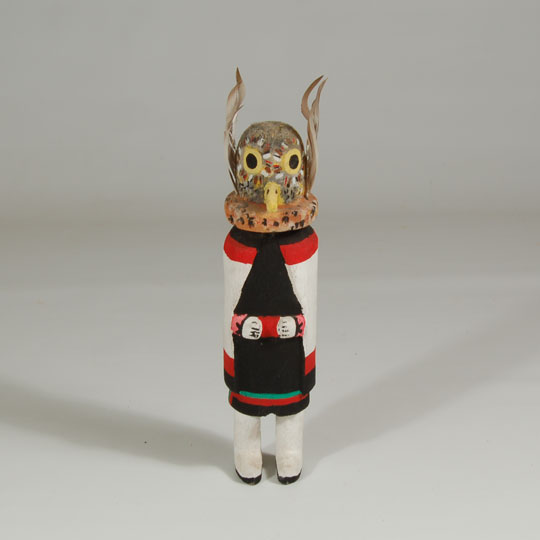 The Hopi Mongwa (Great Horned Male Owl) Katsina, as a warrior, is relentless in persecuting the clowns. He stands to the edge of the dance circle while the clowns are performing and watches disapprovingly of their antics. Near the end of the dance, a group of Mongwa swoops down on the clowns and beats them with yucca whips, douses them with water, and leaves them piled up in the center of the plaza in pain.
The Hopi Mongwa (Great Horned Male Owl) Katsina, as a warrior, is relentless in persecuting the clowns. He stands to the edge of the dance circle while the clowns are performing and watches disapprovingly of their antics. Near the end of the dance, a group of Mongwa swoops down on the clowns and beats them with yucca whips, douses them with water, and leaves them piled up in the center of the plaza in pain.
This Hopi Mongwa Wuhti is the Great Horned Female Owl Katsina. She has only been published in Fewkes' article on Hopi Katsinas and has appeared nowhere else. Present-day Hopi are not aware of the female version, so perhaps it has not been seen in over a hundred years.
Historic Zia Pueblo Polychrome Jar with Birds and Rainbows - C3753.66
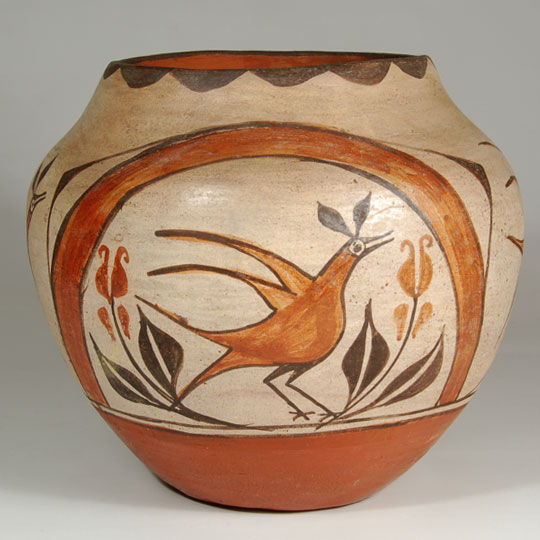 Rainbow arcs began appearing on Zia pottery around 1880. They are often presented in red outlined in black, and less often in ochre outlined in black. This jar has simple rainbow arcs in red outlined in black, and attached to the rainbows are capped triangles partially filled with black.
Rainbow arcs began appearing on Zia pottery around 1880. They are often presented in red outlined in black, and less often in ochre outlined in black. This jar has simple rainbow arcs in red outlined in black, and attached to the rainbows are capped triangles partially filled with black.
Birds began to appear on Zia Pueblo jars as early as 1820 and continue to be used today. They became more prominent beginning in the 1870s, usually associated with floral patterns and rainbow arcs, as they are here. There are two birds under rainbows and two without rainbow protection. The birds have orange bodies with black feathers on their heads. They have the typical round eyes. The birds under the rainbows are accompanied by floral elements with split leaves. The birds without rainbow protection have no floral elements.
Cochiti Pueblo Polychrome Antelope Figurine by Elizabeth Trujillo - C3702F
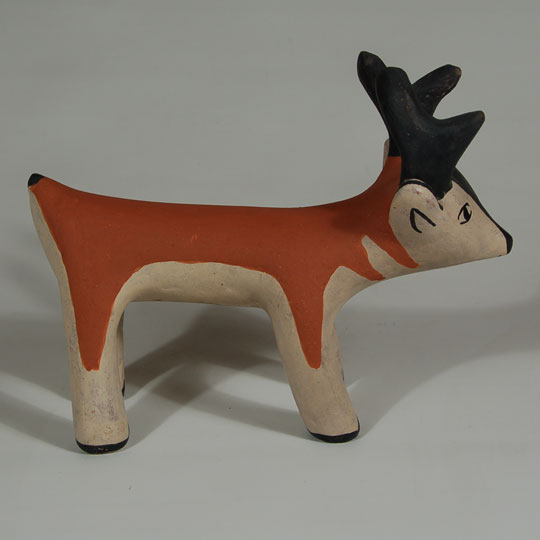 Game animals are very important to Native Americans, not for trophy hunting, but for food. The pueblos of New Mexico celebrate animal dances as a plea for abundant game animals and again in thanks for such.
Game animals are very important to Native Americans, not for trophy hunting, but for food. The pueblos of New Mexico celebrate animal dances as a plea for abundant game animals and again in thanks for such.
It is probably because of their respect for and dependence on game animals that Cochiti potters make animal figurines such as this antelope. I don't know if Elizabeth Trujillo has made many animal figurines because the only pottery of hers we have had in the past has been small bowls. I certainly would say that this is not her first one as it is quite well made and not an item from a beginner.
Cochiti Pueblo Whimsical Duck Figurine - C3702G
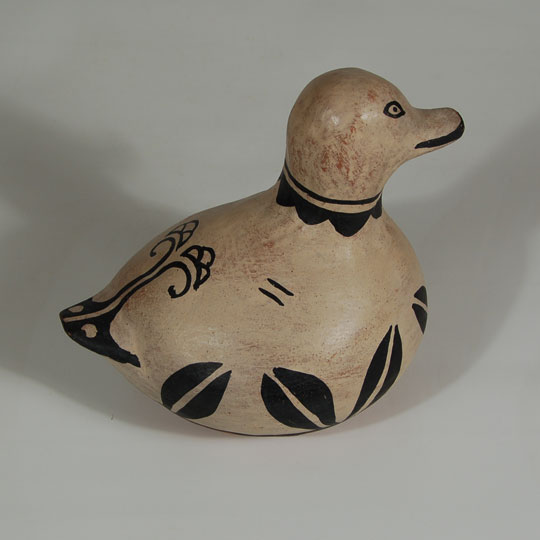 Cochiti Pueblo potters are recognized as the 20th century's most adept potters at making humorous figurines, whether they are people or animals. Figurine pottery has always been a tradition at Cochiti. Long before other pueblos were producing figurative pottery, Cochiti was in the forefront. This whimsical duck is a good example of Cochiti figurative pottery. It is unsigned but was obviously made by an experienced potter.
Cochiti Pueblo potters are recognized as the 20th century's most adept potters at making humorous figurines, whether they are people or animals. Figurine pottery has always been a tradition at Cochiti. Long before other pueblos were producing figurative pottery, Cochiti was in the forefront. This whimsical duck is a good example of Cochiti figurative pottery. It is unsigned but was obviously made by an experienced potter.
Cochiti Pueblo Seated Santa Claus with 2 Children by Grace Suina - C3702C
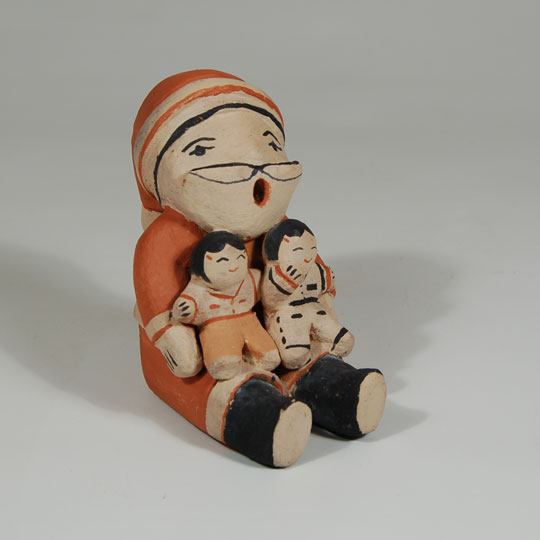 Grace Suina is a daughter of Ada Suina but I have not found any other biographical information on her at this time. We will update her information after we learn more.
Grace Suina is a daughter of Ada Suina but I have not found any other biographical information on her at this time. We will update her information after we learn more.
This Santa Claus storyteller was very well made so it is assumed that Grace has been potting for quite some time. Her children resemble those on her mother's storytellers.
“Coyote and the Winter Shawl” Storyteller with 4 Children by Snowflake Flower - C3702B
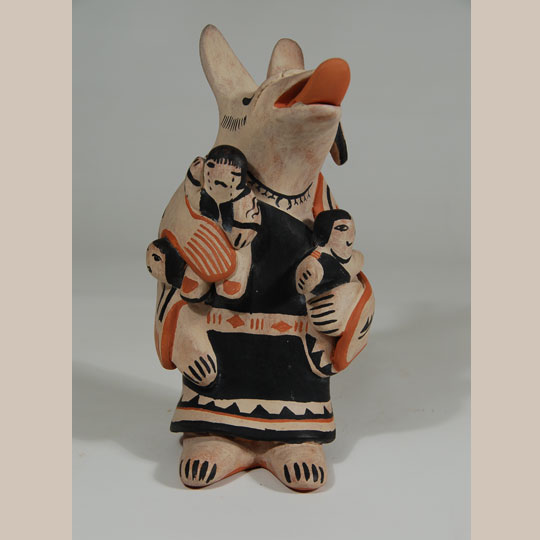 Snowflake Flower was named Estephanita after her grandmother Estephanita Herrera, but she is known as Stephanie or Snowflake Flower. She is a sister to Ada Suina. She attended the University of New Mexico and received her BS in Education in 1985. She had started making pottery figurines around 1979 and has specialized in storytellers, nacimientos, owls and other figurines.
Snowflake Flower was named Estephanita after her grandmother Estephanita Herrera, but she is known as Stephanie or Snowflake Flower. She is a sister to Ada Suina. She attended the University of New Mexico and received her BS in Education in 1985. She had started making pottery figurines around 1979 and has specialized in storytellers, nacimientos, owls and other figurines.
Cochiti Pueblo Seated Male Figurine with Head Bonnet - C3702A
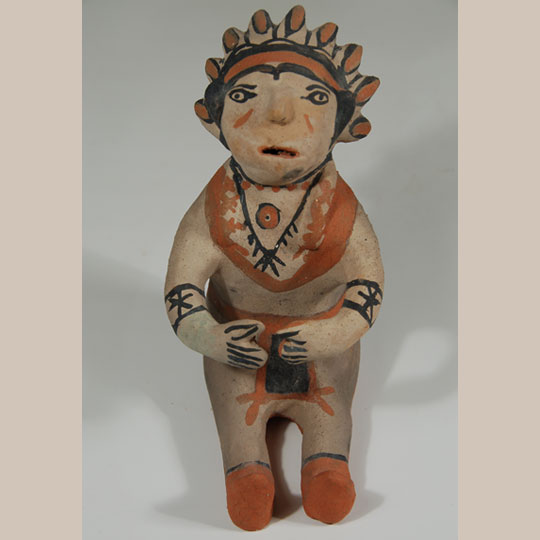 This is a wonderful pottery figurine and different from most seen in the past. Unfortunately, the potter will not get credit for such a creation because there is no name on the figurine. The bulging eyes are a familiar look but I cannot recall whose style that is. The feather head bonnet is not one I recall ever seeing in the past. The style of the Cochiti Pueblo figurine reminds me of the work of Ben Eustace.
This is a wonderful pottery figurine and different from most seen in the past. Unfortunately, the potter will not get credit for such a creation because there is no name on the figurine. The bulging eyes are a familiar look but I cannot recall whose style that is. The feather head bonnet is not one I recall ever seeing in the past. The style of the Cochiti Pueblo figurine reminds me of the work of Ben Eustace.
Navajo Rug of Teec Nos Pos Origin - C3701
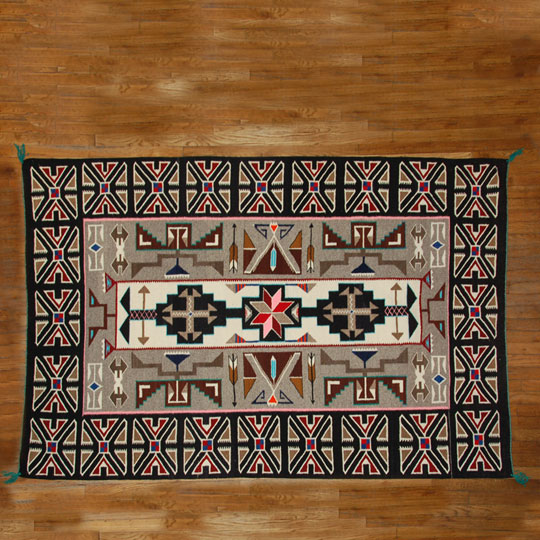 Navajo rugs from the Teec Nos Pos area of the reservation are considered the most beautiful designed rugs of all and, at the same time, considered the least Navajo of all. The designs have been influenced by early traders at the trading post providing designs of Persian rugs to the weavers and, in one instance, painting such designs on the exterior walls of the trading post in the hopes that the weavers would copy those designs.
Navajo rugs from the Teec Nos Pos area of the reservation are considered the most beautiful designed rugs of all and, at the same time, considered the least Navajo of all. The designs have been influenced by early traders at the trading post providing designs of Persian rugs to the weavers and, in one instance, painting such designs on the exterior walls of the trading post in the hopes that the weavers would copy those designs.
Teec Nos Pos (circle of cottonwoods) Trading Post was established in 1905 by Hambleton (Hamp) Bridger Noel, the first white man who was able to win the approval of the local Navajo to set up a trading post on their land. Ten years earlier, two potential traders were driven off. Hamp Noel married Eva Foutz in 1911 and eventually the Foutz family took over the post and still operate it today.
Cochiti Pueblo Flight to Egypt Figurine Set by Josephine Arquero - C3702E
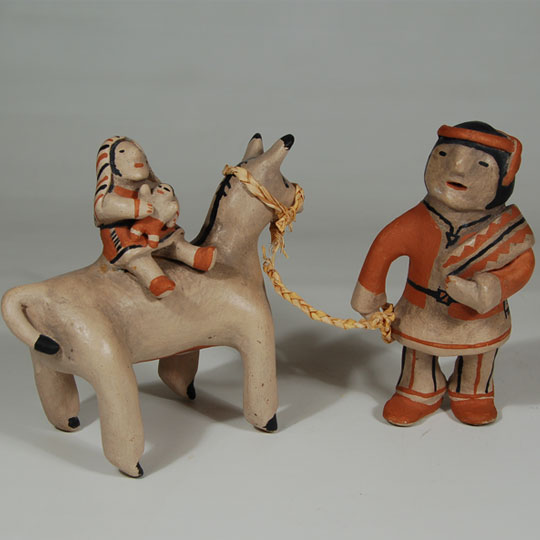 Although this set is not signed with the name of the artisan, I am positive it was made by Josephine Arquero. I have had such sets in the past and they were very similar to this one. The braided rope is exactly like that on a previous set we had at the gallery.
Although this set is not signed with the name of the artisan, I am positive it was made by Josephine Arquero. I have had such sets in the past and they were very similar to this one. The braided rope is exactly like that on a previous set we had at the gallery.
This Cochiti Pueblo set has all the attributes of what one would consider folk art. Joseph is pictured taller than the donkey but Mary is very much diminutive in scale compared with Joseph. That is the charm of the set.

